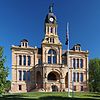
Fridolin Heer was a Swiss-born and trained architect who immigrated to the United States in 1864 and set up a practice in Dubuque, Iowa shortly thereafter. He was joined in his practice by his son, Fridolin Heer Jr.
Purcell & Elmslie (P&E) was the most widely know iteration of a progressive American architectural practice. P&E was the second most commissioned firm of the Prairie School, after Frank Lloyd Wright. The firm in all iterations was active from 1907 to 1921, with their most famous work being done between 1913 and 1921.
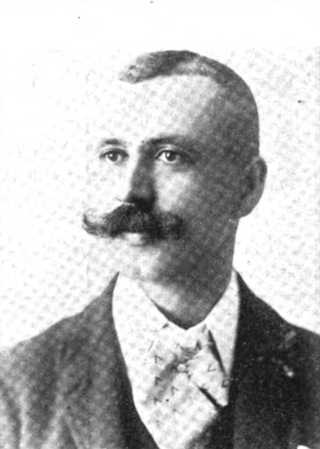
Frank Shaver Allen (1860–1930), usually known as F. S. Allen was a significant Joliet, Illinois-based American architect noted for his Richardsonian Romanesque school designs.
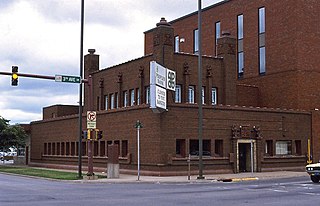
The Peoples Savings Bank in Cedar Rapids, Iowa, was designed by Louis Sullivan. It was the second of a number of small "jewel box" banks in midwest towns designed by Sullivan during 1907 to 1919. It was built in 1911, and it was individually listed on the National Register of Historic Places in 1978. In 2014 it was included as a contributing property in the West Side Third Avenue SW Commercial Historic District.
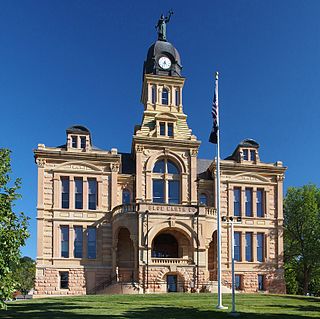
The Blue Earth County Courthouse is the courthouse of Blue Earth County, Minnesota, United States, in the city of Mankato, the county seat. It is listed on the National Register of Historic Places.
David S. Gebhard was a leading architectural historian, particularly known for his books on the architecture and architects of California. He was a long-time faculty member at the University of California, Santa Barbara, and was dedicated to the preservation of Santa Barbara architecture.

Charles Sumner Frost was an American architect. He is best known as the architect of Navy Pier and for designing over 100 buildings for the Chicago and North Western Railway.
Sidney Lovell was an American architect best known for designing mausoleums, and to a lesser extent theaters and opera houses. His first cemetery commission, the mausoleum at Rosehill Cemetery in Chicago, Illinois, is considered his best work. He obtained a patent on an improved mausoleum ventilation system in 1917. Two of his works are listed on the National Register of Historic Places.

Mifflin Emlen Bell, often known as M.E. Bell, was an American architect who served from 1883 to 1886 as Supervising Architect of the US Treasury Department. Bell delegated design responsibilities to staff members, which resulted in a large variety of building styles, including Second Empire, Châteauesque, Queen Anne and Richardsonian Romanesque.

Henry C. Koch was a German-American architect based in Milwaukee, Wisconsin.
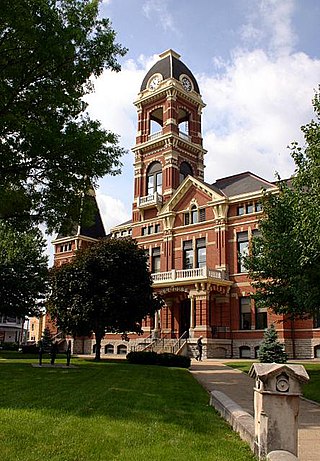
Albert C. Nash (1825-1890) was an American architect best known for his work in Milwaukee and Cincinnati.

Proudfoot & Bird was an American architectural firm that designed many buildings throughout the Midwest region of the United States. Originally established in 1882, it remains active through its several successors, and since 2017 has been known as BBS Architects | Engineers.

Edwin Hawley Hewitt was an American architect from Minnesota. In 1906, he designed the Edwin H. Hewitt House in the Stevens Square neighborhood of Minneapolis, listed on the National Register of Historic Places in 1978.
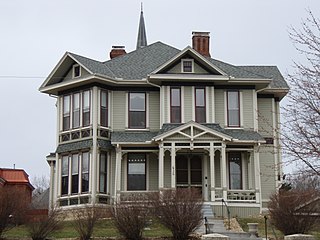
George W. Orff (1835-1908), was an American architect of Bangor, Maine and Minnesota.

Fremont D. Orff (1856-1914) was an American architect.

Charles Emlen Bell (1858–1932), often known as C.E. Bell, was an American architect of Council Bluffs, Iowa and Minneapolis, Minnesota. He worked alone and in partnership with John H. Kent and Menno S. Detweiler. He also worked as part of Bell, Tyrie and Chapman. A number of his works are listed on the U.S. National Register of Historic Places.

Edmond J. Eckel was an architect in practice in St. Joseph, Missouri from 1872 until his death in 1934. In 1880 he was the founder of Eckel & Mann, later Eckel & Aldrich and Brunner & Brunner, which was the oldest architectural firm in Missouri prior to its eventual dissolution in 1999.

Gurdon P. Randall was an architect in Chicago, Illinois. Early in his career, he studied in Boston, Massachusetts, in the office of Asher Benjamin. He moved to Chicago when he was 30, and practiced there for 34 years, focusing on large institutional architecture. He designed a number of notable buildings, including several that survive and are listed on the National Register of Historic Places.
Elbert B. Watson (1879-1963), commonly known as E.B. Watson, was an architect based in Norfolk, Nebraska.

John P. Eisentraut (1870-1958) was an American architect most closely associated with South Dakota. Eisentraut designed a number of buildings, including Carnegie libraries and courthouses, several of which are listed on the National Register of Historic Places. He was one of South Dakota's leading architects during the first quarter of the twentieth century.




